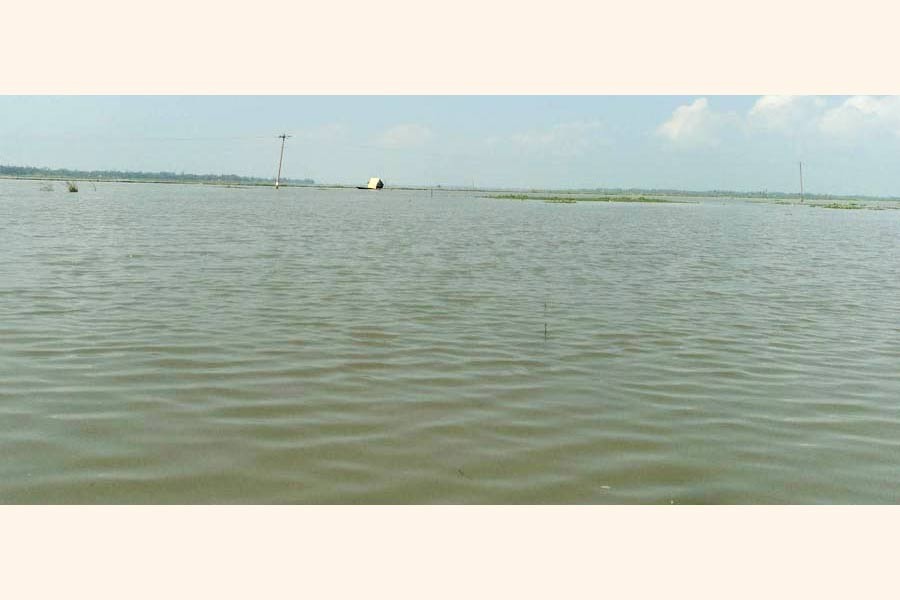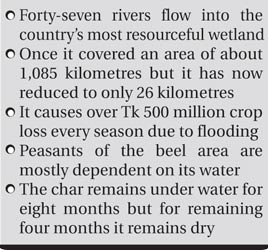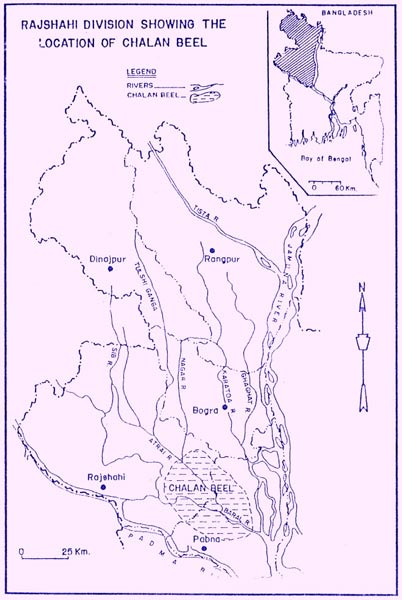
Chalan Beel-largest wetland in Bangladesh
EMDADUL HAQUE | Friday, 4 October 2019

NATORE, Oct 03: Due to absence of a sluice gate in Chalan Beel, one of the largest wetlands in the country, sufferings of over five million people mount during both monsoon and winter.
Haphazard water release from adjacent small and big water bodies into Chalon Beel is causing sufferings of the people including businessmen, peasants, passersby, students and fishermen of Naogaon, Natore, Pabna and Sirajganj districts. Spreading across eight upazilas of three districts of the country, Chalan Beel is a series of wetlands connected by channels of water in the lower Atrai basin.
Spreading across eight upazilas of three districts of the country, Chalan Beel is a series of wetlands connected by channels of water in the lower Atrai basin.
During the rainy season, these wetlands become a single body of water with dense aquatic vegetation supporting diverse wildlife.
The banks of Chalan Beel are covered in a variety of fauna, which is inhabited by at least twenty-seven species of mammals, and thirty-four species of reptiles, with amphibians including seven species of frogs and toads.
Reptiles include turtles, tortoises, lizards and a number of snake species.
Forty-seven rivers and other waterways flow into the Chalan Beel. As silt grows up in the beel, its size is being reduced.
Chalan Beel is an extensive lowland area in the lower Atrai basin, and spreads across Singra and Gurudaspur upazilas on Natore district, Chatmohar, Bhangura and Faridpur upazilas of Pabna district, and Ullahpara, Raiganj and Tarash upazilas of Sirajganj district.
It consists of a series of beels connected to one another by various channels to form a continuous water body during the rainy season.
Although the beel area expands into a vast water body with dense aquatic vegetation as long as the Jamuna remains flooded during the monsoon months, it dries out in the winter months, leaving only patches of water in the central parts of this zone. Chalan Beel is fast silting up. In the past it covered an area of about 1,085 km but was reduced to 368 km in 1909, of which only 85 km remained underwater throughout the year. It has since shrunk to only 26 kilometres.
Chalan Beel is fast silting up. In the past it covered an area of about 1,085 km but was reduced to 368 km in 1909, of which only 85 km remained underwater throughout the year. It has since shrunk to only 26 kilometres.
Farmers of the region who depend on agriculture based jobs are seeking immediate step to make the sluice gate so that they can use the water as per their need in both dry and monsoon seasons.
The beel losses over Tk 500 million crops due to submersion every season, said a sub-assistant agriculture officer.
If the authorities concerned take immediate step to keep water by making sluice gate, the farmers of the four districts can grow over 2.0 millions tonnes of fresh rice in the rainy season, said deputy director of Department of Agriculture Extenuation Rafiqul Islam of Natore district.
The farmers sow Aman paddy in Chaitra to Baishakh month to harvest the crops in Ashwin to Kartik.
If the seedlings remain safe, farmers can harvest minimum 30 maunds of paddy from a bigha of land without spending production cost.
The peasants of Chalan Beel area mostly dependent on its water. If the water remains under control, they can grow paddy, vegetables and spices well.
Besides, the fate of the extreme poor farmers of Tarash and Royganj upazilas of Sirajganj, Gurudaspur and Singra upazila of Natore, Chatmohor and Bhangura upazilas of Pabna, Atrai upazila of Naogaon district of the Rajshshi division will be blessed by taking steps to dig the canal.
Chalan Beel area dries up in Magh and Falguni for want of digging year after year.
As a result, irrigation work is being hampered and the indigenous fish species are on the verge of extinction.
Although cost of transporting goods by vessels is low, during drought all the waterways in the area remain closed pushing up the expenditure, said trader Aslam Ali under Chatmohor upazila.
According to the chronicles of the Chalan Beel, composed by Principal Md Abdul Hamid, the vast char area remains under water for eight months but for the remaining four months it remains empty.
Meanwhile, thousands of fishermen have become jobless due to the drying up of rivers.
They are also forced to change their profession to manage their family expenditure.
Environmentalist Dr SM Muktimahmud said dredging work of the Atrai river started last year.
Member Secretary of River Protection Committee SM Mizanur Rahman said if the rivers are dug immediately, the heritage will return for the country.
Besides, the Beel is losing its area due to unplanned construction of houses on its dam.
A fishermen Lokman Hossain at Nilchora village under Shinga upazila said after the recession of water, they caught boal, shing, pabda, putty, carp, salmon and other fishes.
They are not getting adequate fish as the beel doesn't keep water for a long time, he added.
Dr SM Muktimahud, a teacher of the Department of Geography of Chatmohar College, said it is noteworthy that the slopes of the river basin in the area of channel beel are low.
A fisherman Ramjan Ali at Damdoma village said he would catch Baim fish with Doyar, a sort of fishing trap, to manage the family demand from Asar to Falgun a few years back. But he is now suffering much with scarcity of fish.
A school boy Sazid Hossain, 13, under Atrai upazila said he goes to school riding on boat as the way is submerged every monsoon.
He is to pay extra money and time for the condition from Jaistha to Magh month every year.
Nilchara, Pakribaria, Bondor and Kaliganj area of Singra upazila is suitable for growing onion, garlic and ginger.
The alluvium is suitable for growing rabi crops easily if they are provided with water by digging the Beel.
Samad Pramanik of Royganj uapzila of Sirajganj district said when the Brahmaputra River changed its course and transformed into the present Jamuna, it was the creation of the Chalan Beel.
It was probably a backdrop until it became a vast lake with the incorporation of the abandoned tract of the Karatoa and Atrai rivers, he added.
A large portion of the beel dries up into a water cavity and the farmers of the adjacent upazila grow Boro rice, sesame, onion, mustard, garlic, potato, maize, ground-nut and other rabi crops, said farmer Esharat Alison,60, son of late Azaher Ali at Dakhin Domdoma village under Shingra upazila of Natore district.
The farmers can grow garlic and onion in the basin of Chalan Beel without tilling the land, said deputy director of DAE, Naogaon.
Executive engineer of Natore Water Development Board (WDB) Md Mahbubur Rahman said the government has taken a project to navigate the free water body to keep the water flow normal round the year considering betterment of the farmers.
The farmers can use the water according to their need both in rainy and dry seasons simultaneously to boost the crops, he added.
reporter.fe@gmail.com